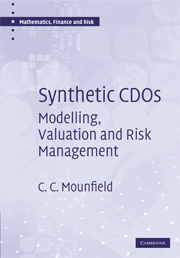Book contents
- Frontmatter
- Contents
- Preface
- Acknowledgements
- 1 A primer on collateralised debt obligations
- 2 Modelling of obligor default
- 3 Valuation of credit default swaps
- 4 Credit indices
- 5 Valuation of default baskets
- 6 Valuation of synthetic CDOs
- 7 Phenomenology of the standard market model
- 8 Risk quantification of synthetic CDOs
- 9 Implied and base correlations
- 10 Extensions of the standard market model
- 11 Exotic CDOs
- 12 Correlation trading of synthetic CDO tranches
- 13 Risk management of a portfolio of synthetic CDOs
- 14 Hedging simulation of structured credit products
- Appendix A Explanation of common notation
- Appendix B Simulated annealing
- References
- Index
7 - Phenomenology of the standard market model
Published online by Cambridge University Press: 06 July 2010
- Frontmatter
- Contents
- Preface
- Acknowledgements
- 1 A primer on collateralised debt obligations
- 2 Modelling of obligor default
- 3 Valuation of credit default swaps
- 4 Credit indices
- 5 Valuation of default baskets
- 6 Valuation of synthetic CDOs
- 7 Phenomenology of the standard market model
- 8 Risk quantification of synthetic CDOs
- 9 Implied and base correlations
- 10 Extensions of the standard market model
- 11 Exotic CDOs
- 12 Correlation trading of synthetic CDO tranches
- 13 Risk management of a portfolio of synthetic CDOs
- 14 Hedging simulation of structured credit products
- Appendix A Explanation of common notation
- Appendix B Simulated annealing
- References
- Index
Summary
Nothing in life is to be feared, it is only to be understood.
Marie CurieIntroduction
In the previous chapter we outlined the standard market model for synthetic CDO tranche valuation and provided a number of different methods for the valuation of synthetic CDO tranches within the context of this model. In this chapter we start to analyse the properties of these models. For the sake of clarity we focus mostly on the Monte Carlo and semi-analytic recursive models for constructing the portfolio loss distribution.
In Section 7.2 the baseline scenario to be analysed will be introduced and the approximations made in the analysis described (and justified). Section 7.3 looks at a number of basic tranche simulation statistics to illustrate some of the problems that are encountered when applying Monte Carlo methods to tranche valuation. Section 7.4 analyses the portfolio loss distribution for a range of different input parameters. As we will see in subsequent chapters virtually all synthetic CDO behaviour can be explained by understanding the behaviour of the loss distribution. Following this in Section 7.5 the behaviour of the tranche present value (or equivalently the par spread) for a range of input parameters is quantified. What will quickly become apparent is that tranches have a rich and complex behaviour. Section 7.6 briefly revisits the results for default baskets obtained in Chapter 5 and provides an explanation for the phenomenology obtained. Finally in Section 7.7 we review the important points raised in the chapter and motivate our next steps.
- Type
- Chapter
- Information
- Synthetic CDOsModelling, Valuation and Risk Management, pp. 137 - 159Publisher: Cambridge University PressPrint publication year: 2008



